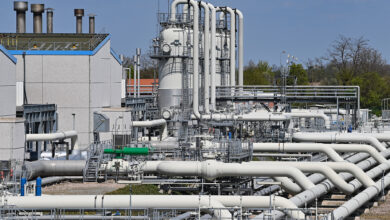Muslim dynasties
About a century after Amr Ibn al-Aas's armies set up camp in al-Fustat and the Muslim religion was introduced into Egypt in 641CE, a series of environmental changes would affect the Delta.
Sea levels rose again, breaching the sand bar separating the then fresh-water Lake Tinnis, turning it into a lagoon, which we today call Manazalah. The lagoon's brackish waters covered Tanis' farmland, almost instantly reducing it from the status of a vibrant major city to a third-rate village. Today, the adjacent village of San al-Hagar is ranked as one of the poorest villages in Egypt.
The Tanitic refugees were forced, like their forefathers before them, to move to another place. Some may have set up in the island town of Tennis, an island in the Manzalah Lagoon, which flourished as a port over the next few centuries, taking advantage of the lake’s newly formed link to the sea, storing fresh Nile flood water in cisterns for the entire year in order to survive.
Bad luck would follow though, and within six centuries the threat of the crusades led the Arab sultan Qaitbay to raze Tennis. The Tennis people, true to their refugee heritage, abandoned it for the better fortified Dumyat in the west.
Around the eighth century another refugee town would disappear. Scientists are yet to agree as to the reason why Eastern Canopus, a city near Alexandria to which most of Heracleion's survivors migrated almost seven centuries earlier, sank.
One theory is that a series of devastatingly high floods, recorded by the Roda Nilometer in the years 741 or 742, weighed down the land the city stood on, pushing it down and letting in the sea. Others suggest the Canopic branch had dried up some time before, and so an earthquake dropped the city eight meters below sea level.
Either way, the ruins of these two cities remained at the bottom of Abu Kir bay for almost 1200 years until fishermen in the 1920s showed their curious finds to Prince Omar Tousson, who went on to patron one of the earliest underwater archaeological missions in Egypt.
The Canopic branch, as well as the Sebyynittic and Pelusiac branches, are thought to have disappeared just before or during this time, as little record of them appears in Arab historians' accounts.
Apparently Roman endeavors that saw provincial Egypt turned into the breadbasket of their empire are partly to blame. On clearing the Rosetta, or ancient Bolbitic branch, to help irrigate more land and allow water traffic through it, its quicker flow gradually robbed the Canopic branch–flowing nearby to the west–and possibly the Sebynettic–to the east–of their waters until they completely silted up.
Needless to say, the economic fallout for the communities that settled the banks of the branches proved crippling. Without a major waterway, the towns lost out on a vital waterborne transport network whereby trade and communication were facilitated, fields that relied on the inundation of these branches were left parched, and people had little water to drink.
Nowhere was this devastation more apparent than in Alexandria, which relied solely on the Canopic for communication, trade and drinking water. And so its people, along with other communities, would be the first refugees in the Delta affected by human-induced environmental change, and this once great city of knowledge and learning would disappear from the history books by the 8th century CE.
The historic port city of Pelusium to the complete east would also fall, due to an uplift of the land beneath it that cut it off from both the Nile and the Mediterranean, leaving it surrounded by the Sinai desert.
As a final indignity to ancient Alexandria, two earthquakes in the years 1303 and 1323 brought its famous lighthouse to the ground.
Modern Egypt
The Nile Delta had settled into two branches, the Phatnitic and the Bolbitic, the pair we know today as Damietta and Rosetta. The four lagoons of Manzala, Burulus, Idko and Maryout had formed and became prime fishing waters, a calmer alternative to the raging Mediterranean, and settlements of fishermen dotted the coasts of these lagoons.
Sandwiched between the Mediterranean Sea and the Burullus Lagoon lay a dune belt that stretched along the Delta's northern flank between Damietta and Burg alBurulus. Like every other inch of the Delta, and true to the morphing nature of sand dunes, this dune belt was in a perpetual state of motion, and with it, its inhabitants. The dunes, it is thought, formed as a result of the Sebbenitic branch's silt being blown by easterly winds from its dried-up river bed.
The fishermen and migrants who settled here knew that, and so had to keep up with this inexorable march, for the waters of both sea and lagoon bounded them from north and south. Today's village of Kafr Khushuai is but an iteration of an earlier Kafr Khushai that was inundated by sand sometime during the 19th century, the tip of a minaret jutting from the sand a stark reminder of its existence.
More man-made change would come.
Napoleon's dream of a barrage north of Cairo to boost the Delta's crop production for export to France was realized in 1835 by Mohamed Ali, the self appointed viceroy of Egypt, after recognizing cotton's potential as white gold. This triggered a 130-year marathon of dam building–including the British backed Aswan Dam in 1906 and its subsequent raisings, as well as five other barrages along the Nile and its branches.
This exploitation of every last drop of water for agriculture meant the Nile Delta lost ground in its 8000-year-old battle with the Mediterranean, the sea aggressively attempting to regain rightful ownership of its basin, eroding swathes of the coast line between Port Said and Alexandria, and the city of Rashid witnessing the loss of its summer resort cabins with its coastline retreating at up to 100 meters a year.
The definitive nail in the coffin came with the completion of part of the High Dam in Aswan in 1964, replacing the Aswan Dam. With the Nile now completely denied its fighting waters, and more importantly its silt, it would be just a matter of time before the Mediterranean slowly ate the rest of its way back into the delta, leading the marine geologist Daniel Stanley to describe this most recent of the Nile Delta's phases as its "Destruction Phase."
Indeed, the cities of Alexandria, Rashid, Ras al-Bar and Port Said have only been preserved by concrete wave breakers set up along their coasts over the past few decades at huge expense, the most recent bill standing at LE360 million. Ironically, it is the very sand dunes that threaten the northern-most villages with their migration, that acted as a free, natural defense system to the Mediterranean's eroding waters in the regions they occupy.
This is the second of a three-part series on the topic of Nile delta migration.



